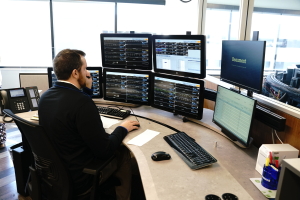by
Lauren Dubinsky, Senior Reporter | February 10, 2020

GE Healthcare's Digital Central Monitoring Unit (DCMU) is staffed with technicians monitoring the flow of cardiac data.
From the January/February 2020 issue of HealthCare Business News magazine
The hazards of alarm fatigue are well documented in healthcare. For almost a decade, ECRI Institute has considered alarm fatigue a major health technology hazard, and although progress is being made, perfecting alarm management remains a work in progress.
Historically, patient monitoring systems have been toward the top of the list when it came to technology causing fatigue due to unnecessary alarms. Today, some patient monitoring companies are offering features that allows for customizable alarm limits based on the patient’s baseline reading. Innovations like this allow clinicians to tailor notifications based on a given patient’s specific condition instead of using default limits that may be too wide or narrow for the individual.
“As part of our evaluations we spoke with hospitals that use these monitoring systems,” Priyanka Shah, senior project engineer of health devices at ECRI, told HCB News. “The common theme is that these data are very helpful for them to make a case, to modify alarm limits or to change the priority of certain alarms.”
Another way to curb unnecessary patient monitor alarms is to visualize the data and discover patterns. Nihon Kohden created a platform called Aware Alarm Management that gives clinicians a report listing the times that each device set off an alarm. It shows all the different alarm incidents, enabling the hospital to quantify how well their alarm management strategies are working.
“Over one week they could assess all of the alarms that are happening on a particular unit and then implement a new strategy, such as replacing ECG leads every 24 hours,” said Elias Bitar, director of patient monitoring, marketing and business development at Nihon Kohden. “Then, over the next week, they can actually track to see how effective that policy has been at reducing alarm fatigue.”
ECG leads are commonly considered a nuisance alarm since they often occur when there is not a cardiac event, according to Shah. Still, failing to recognize and address a leads-off alarm may cause higher-priority alarms to not sound despite a serious cardiac event.
GE Healthcare takes a command center approach to addressing alarm fatigue. Its Digital Central Monitoring Unit (DCMU) is staffed with dozens of trained technicians that constantly monitor the flow of patients’ cardiac data. For instance, if a lead wire has been off for too long or a patient’s heart rate is too high or low, the technician will send a broadcast alert to a specific care team in the form of a text message or phone call.
